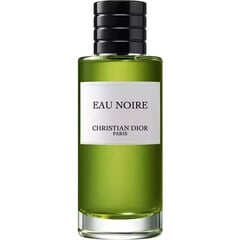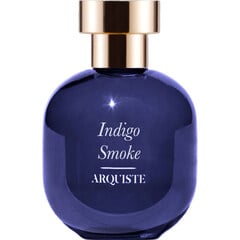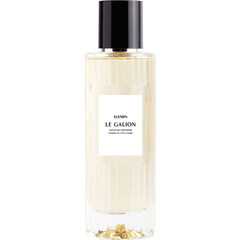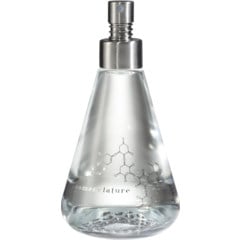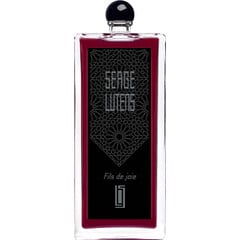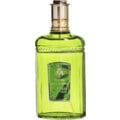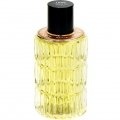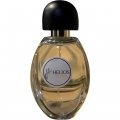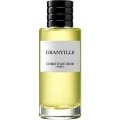
Intersport
Reviews
Filter & sort
Translated
Show original
Eau(x) Noire(s) - I was dreaming..
I would never have dreamed of writing a commentary on Eau Noire, a lot of informative things have been said about this Dior neo-classic, and on top of that Eau Noire had a real shadowy existence for years: at times only available in France (better centralized in Paris, more precisely Avenue Montaigne) on demand in the store, quasi under the counter, then at times only in the French online shop, etc., etc., etc., etc. Online store, etc. - in short, it was to be found, but not obviously. This was to change with the appointment of Francis Kurkdjian, the former creator of Eau Noire, as the new house perfumer chez Dior. Eau Noire is back, albeit more as a marketing strategy (it's LVMH), and this time also 'fully' in the program for the time being, en France and everywhere.
Eau Noire originally had an extremely original, even amusing raison d'être. Even before Dior went all-out with the Privée range and left no stone unturned on which Monsieur Dior had at some point sat, leaned or rested to dedicate a fragrance, three fragrances appeared with the hiring of fashion designer Hedi Slimane, at that time still quite Americanistically labeled as cologne, the most extraordinary of which was Eau Noire. Hedi, it was quoted, had already dreamed the fragrance in his youth, so the perfume happened to him in a dream, passively, like Karl Valentin or the many examples of artistic intuition via dream induction, the dream as a productive state of consciousness, from the earliest shamanistic rituals to the measurement of the senses and mapping of the subconscious in the 19th century, Hedi, yes, came up with the composition of Eau Noire in his sleep, Francis then had to realize the whole thing or better: interpret it.
Eau Noire was a fragrance with character, far more striking than the Cologne Blanche or the popular Bois d'Argent, which appeared at the same time, and it was above all the first designer fragrance since Goutal's Immortelle Ode Sables (1985) to be so bluntly dedicated to this ingredient. I also suspect that the latter had far more influence on Eau Noire than the reverie, the fragrances of such specialized author:interior perfume houses, such as Annick Goutal, were more highly regarded in the fashion industry with their appreciation of craftsmanship, savon-faire, etc., than fragrances of the designer competition. Yet Eau Noire has always been more of a multi-faceted darkened lavender with bouquet garni decor and licorice/immortelle framing than a pure-bred immortelle eau.
Nevertheless, when the French Nez magazine published a small booklet dedicated entirely to Immortelle in 2022, I was particularly curious about the 'Genealogy' section - a neatly researched chronological overview of an 'ingredient', depending on the author. For me, the Immortelle genealogy was rather patchy, almost sloppy. It was also surprising that Eau Noire of all fragrances was not included, but when I asked Kurkdjian and Dior, they allegedly denied any active involvement of Immortelle in Eau Noire. Yes, you read that right: Eau Noire, Immortelle, mais non! It can happen that fast.
Of course, there are ways to create an immortelle note without using natural immortelle extracts, but it seems to me that the narrative of a fragrance is (retrospectively?) polished by the manufacturer with supposed notes. Even though, under LVMH, even the former nonchalance house Givenchy briefly had an "Immortelle fragrance" in its program with Immortelle Tribal (2015) that was stripped down to insignificance - the idiosyncratic note probably fits so poorly into the Dior world at the moment that this neo lavender classic has to make do without it altogether.
A few months after the publication of the booklet, Eau Noire reappeared in the Dior portfolio, first in a set with Cologne Blanche and Bois d'Argent - quasi as a reminiscence of Kurkdjian's attitude. Even though the press release stated that Eau Noire was back in its original form, this is probably the version that is furthest removed from the original version.
Gone are the days of the added green colorant (cosmetic greenwashing?) that gave the fragrance a certain darkness, but also gone are the days of a clear immortelle note. This has been toned down here, shifted more in the direction of licorice or rather not fully processed licorice (Ellena's Brin de Réglisse (2007) sends its regards) and the fragrance appears more airy, more transparent, but also smoother, especially in the first few hours. An effective and slightly artificial note of dryness, which I also encountered more strongly in Le Couvent's Sperone (2023), or even more strongly in Ganymede Extrait (2023), noticeably clears up the formerly dark Eau Noire. Admittedly, Eau Noire by Dior is neither Couvent's landscape idyll nor Bisch's showmanship, fortunately this note fades and with time Eau Noire approaches the profile of earlier versions again, only smoother overall. But perhaps this is exactly what makes the greatness of mediocre reformulations: the fragrance is recognized in its entirety, which is also the case here, but the devil is in the details... Thanks to Dior's indication of the 'formulation number', these are also quite easy to recognize - in addition to the original 'Cologne', ironically the strongest version, I know at least two eau de parfum versions that differ slightly in color and smell, but were still closer to the first version than the 2023 vintage. For the time being, it seems, the shape of the old Eau Noire remains a dream.
Eau Noire originally had an extremely original, even amusing raison d'être. Even before Dior went all-out with the Privée range and left no stone unturned on which Monsieur Dior had at some point sat, leaned or rested to dedicate a fragrance, three fragrances appeared with the hiring of fashion designer Hedi Slimane, at that time still quite Americanistically labeled as cologne, the most extraordinary of which was Eau Noire. Hedi, it was quoted, had already dreamed the fragrance in his youth, so the perfume happened to him in a dream, passively, like Karl Valentin or the many examples of artistic intuition via dream induction, the dream as a productive state of consciousness, from the earliest shamanistic rituals to the measurement of the senses and mapping of the subconscious in the 19th century, Hedi, yes, came up with the composition of Eau Noire in his sleep, Francis then had to realize the whole thing or better: interpret it.
Eau Noire was a fragrance with character, far more striking than the Cologne Blanche or the popular Bois d'Argent, which appeared at the same time, and it was above all the first designer fragrance since Goutal's Immortelle Ode Sables (1985) to be so bluntly dedicated to this ingredient. I also suspect that the latter had far more influence on Eau Noire than the reverie, the fragrances of such specialized author:interior perfume houses, such as Annick Goutal, were more highly regarded in the fashion industry with their appreciation of craftsmanship, savon-faire, etc., than fragrances of the designer competition. Yet Eau Noire has always been more of a multi-faceted darkened lavender with bouquet garni decor and licorice/immortelle framing than a pure-bred immortelle eau.
Nevertheless, when the French Nez magazine published a small booklet dedicated entirely to Immortelle in 2022, I was particularly curious about the 'Genealogy' section - a neatly researched chronological overview of an 'ingredient', depending on the author. For me, the Immortelle genealogy was rather patchy, almost sloppy. It was also surprising that Eau Noire of all fragrances was not included, but when I asked Kurkdjian and Dior, they allegedly denied any active involvement of Immortelle in Eau Noire. Yes, you read that right: Eau Noire, Immortelle, mais non! It can happen that fast.
Of course, there are ways to create an immortelle note without using natural immortelle extracts, but it seems to me that the narrative of a fragrance is (retrospectively?) polished by the manufacturer with supposed notes. Even though, under LVMH, even the former nonchalance house Givenchy briefly had an "Immortelle fragrance" in its program with Immortelle Tribal (2015) that was stripped down to insignificance - the idiosyncratic note probably fits so poorly into the Dior world at the moment that this neo lavender classic has to make do without it altogether.
A few months after the publication of the booklet, Eau Noire reappeared in the Dior portfolio, first in a set with Cologne Blanche and Bois d'Argent - quasi as a reminiscence of Kurkdjian's attitude. Even though the press release stated that Eau Noire was back in its original form, this is probably the version that is furthest removed from the original version.
Gone are the days of the added green colorant (cosmetic greenwashing?) that gave the fragrance a certain darkness, but also gone are the days of a clear immortelle note. This has been toned down here, shifted more in the direction of licorice or rather not fully processed licorice (Ellena's Brin de Réglisse (2007) sends its regards) and the fragrance appears more airy, more transparent, but also smoother, especially in the first few hours. An effective and slightly artificial note of dryness, which I also encountered more strongly in Le Couvent's Sperone (2023), or even more strongly in Ganymede Extrait (2023), noticeably clears up the formerly dark Eau Noire. Admittedly, Eau Noire by Dior is neither Couvent's landscape idyll nor Bisch's showmanship, fortunately this note fades and with time Eau Noire approaches the profile of earlier versions again, only smoother overall. But perhaps this is exactly what makes the greatness of mediocre reformulations: the fragrance is recognized in its entirety, which is also the case here, but the devil is in the details... Thanks to Dior's indication of the 'formulation number', these are also quite easy to recognize - in addition to the original 'Cologne', ironically the strongest version, I know at least two eau de parfum versions that differ slightly in color and smell, but were still closer to the first version than the 2023 vintage. For the time being, it seems, the shape of the old Eau Noire remains a dream.
14 Comments
Translated
Show original
Blandness º Fadeur / tea º Smoke
'Name is smoke and mirrors': this is nothing new when it comes to perfumes, which is a good thing, as there are many releases that contradict their title in terms of composition, or (want to) mislead with the name, depending on your point of view. Arquiste, the brand founded by former Architectural Preservation student Carlos Huber, is fully committed to a partly 'verifiable' history, which serves as the starting point for the respective fragrances. Huber was able to realize the majority of the portfolio with the Givaudan perfumers Rodrigo Flores-Roux and Yann Vasnier. This boys' club has now been expanded by Calice Becker, perhaps not least because of Becker's 'olfactory preservation' with the reissues (1990) of two Balmain classics. Perhaps.
Indigo Smoke, i.e. indigo smoke, or indigo-colored smoke, could suggest a more or less smoky fragrance, even with the mention of a lapsang souchong note and, as always with Arquiste, the historical motif for the genesis of tea incense. But it's been a long time since I've been so fooled by a title like this one, Indigo Smoke.
Indigo Smoke is not a smoky tea fragrance, as Lapsang might suggest. Nor is Indigo Smoke a bluish, or rather indigo-colored fragrance (the epithet indigo is often used, the database here alone easily counts over 100 entries, a trend color...), whatever that may be - how indigo plants smell or whether they actually color the smoke indigo-bluish when burned remains questionable. Luckily for me, smoky per se is far from my favorite notes, even if new records seem to be set again and again when it comes to smoky aromas; in tea fragrances, only Comme des Garçons' Tea (2001) with its tar-like pavement note, or Artisan's eccentric confusion in Cœur de Vétiver Sacré (2010) have been able to inspire me in the long term. Still, I was curious here, Arquiste has always come up with something above average.
The secret star, or the central supporting role in Indigo Smoke is an apricot accord, which never takes center stage. It is modulated too much by the other ingredients and modulates the rest: the apricot accord - even in this choice of words a certain ambiguity resonates, is not unambiguously a fresh or ripe or unripe or dried, etc. apricot. Apricot, which makes it all the more interesting. I know the apricot as a central supporting role in a similar function from Serge Lutens' / Christopher Sheldrake's El Attarine (2008): Apricot, cumin, mandarin, spices; or more recently Marc-Antoine Corticchiato's Immortelle Corse (2019): Apricot + Immortelle. The apricot accord from Indigo Smoke is cooler and more bitter, which is initially supported by a bitter orange/tangerine note, and later by a subtle black tea note: dry, non-smoked, indeed light, more like young Darjeeling than stronger representatives, and more smell than taste). This (tea)leafy dryness provides a counterbalance to the stone fruit note, both fruit and tea can quickly become kitschy. A second facet comes into play here, a hay-like note, which is presumably due to the coumarin used or is noted by Arquiste - albeit geographically rather unsuitable - as a mate tea note, which in turn can appear hay-like. The dosage and also the shading is well chosen, Indigo Smoke is never as bright green as in Villoresi's prudent brew Yerbamate (2001), the coumarin/hay/mate factor is strongly dried out here and closer in color to the gray-brown-black tones of various tea leaves. This could also possibly be part of the New European Bucolic fragrances in this form - but here everything is dustier. In general, the texture of Indigo Smoke seems quite fine-grained and granular - I can only make out many of the notes in trace element-sized potencies, facets flash up again and again for a short time, unsweet vanilla in the smallest quantities, cinnamon peel, a drop of cool vetiver, a little guaiac - only explicitly smoky Lapsang tea remains a ghost until the end. Indigo Smoke is a textural fragrance par excellence, whose concrete cornerstones, profiles and voices appear blurred again and again.
in 2004, the French philosopher and sinologist François Jullien published 'Eloge de la fadeur'. In the foreword to the English version 'In Praise of Blandness', the translator talks about the difficulty of finding an appropriate English equivalent to 'fadeur'. 'Blandness' was chosen, although the German term 'Fadheit' does not quite fit. Fadeur and blandness describe a state of absence of specific, defining, form-giving or outstanding qualities - which, as Jullien shows, does not necessarily have to be bland. The book sheds light on the origins of these 'non-qualities' in Daoist and Confucian traditions in China, among others, and how they affected poetry, painting, aesthetics, and so on. Even if Jullien does not go directly into the gustatory, I can think of specific foods/dishes, part of Chinese food sequences, which are appreciated precisely for their texture and the sensation they create on the palate, more than for any particular flavor.
It is a shame that a note on this subject did not make it into Arquiste's bibliography, but it is understandable in the perfume industry, where special features and unique selling points are always celebrated. Of course, Indigo Smoke is not perfume-turned-blandness, the brand is too American and Calice Becker too French for that, but it is a quiet, delicate fragrance with an amorphous texture that is more of an aura than a space-consuming statement. This style is almost reminiscent of Artisan Parfumeur fragrances of the early 2000s, or the first editions of the Comme des Garçons parfums perfume series. Lovers of stronger perfumes, as they have become more and more fashionable, might be over/underwhelmed with Indigo Smoke. Sometimes I also find myself wishing for a few clearer strokes of color before everything disintegrates back into an atmospheric but difficult to grasp nebulousness.
Interestingly, Olfactive Studio released Smoky Soul (2023) this year on the same theme. Here, too, Lapsang Souchong Tea was still mentioned during the first public presentations. A photo of the iconographic tea fields from Fujian serves as a visual reference. Smoky Soul is not as demonstratively smoky as dried Lapsang leaves. In the meantime, perhaps to emphasize the differences once again, they have switched to Ceylon tea, i.e. tea grown on the island of Sri Lanka. I don't even want to know what happens to you in France when a wine from Bordeaux is suddenly thrown together with a reference from Burgundy - for Céline Verleure, such geographical flexibility is apparently less of a problem. Smoky Soul, designed by Marc-Antoine Corticchiato, is somewhat more immediate, darker overall, somewhat smokier and more osmanthus-heavy (see also Osmanthus Interdite (2007)) than Indigo Smoke; perhaps it is more of a fragrance that pays direct homage to osmanthus-infused teas? Next to it, Indigo Smoke seems like a haze against the stronger contours of Smoky Soul. It also fits better with Olfactive Studio, in a few moments I have to think here of the excellent, eccentric Chypre Shot, (2018), which also flirted with tea/fruit combinations, a release in which apparently, the 3-part constellations practiced by Olfactive Studio let colleagues Duchaufour run to top form.
As different as Smoky Soul and Indigo Smoke may seem at first glance, they do converge in phases as they progress; there is too much overlap between apricot and osmanthus, and also in the tea profiles - neither seems to me to be completely smoked. The finer and altogether more open texture nevertheless remains a special feature of Indigo Smoke; a great addition to Arquiste's portfolio. So blandness as a memorable characteristic after all? I can well imagine Fadeur as a name for it. Many thanks to Parma for the support!
Indigo Smoke, i.e. indigo smoke, or indigo-colored smoke, could suggest a more or less smoky fragrance, even with the mention of a lapsang souchong note and, as always with Arquiste, the historical motif for the genesis of tea incense. But it's been a long time since I've been so fooled by a title like this one, Indigo Smoke.
Indigo Smoke is not a smoky tea fragrance, as Lapsang might suggest. Nor is Indigo Smoke a bluish, or rather indigo-colored fragrance (the epithet indigo is often used, the database here alone easily counts over 100 entries, a trend color...), whatever that may be - how indigo plants smell or whether they actually color the smoke indigo-bluish when burned remains questionable. Luckily for me, smoky per se is far from my favorite notes, even if new records seem to be set again and again when it comes to smoky aromas; in tea fragrances, only Comme des Garçons' Tea (2001) with its tar-like pavement note, or Artisan's eccentric confusion in Cœur de Vétiver Sacré (2010) have been able to inspire me in the long term. Still, I was curious here, Arquiste has always come up with something above average.
The secret star, or the central supporting role in Indigo Smoke is an apricot accord, which never takes center stage. It is modulated too much by the other ingredients and modulates the rest: the apricot accord - even in this choice of words a certain ambiguity resonates, is not unambiguously a fresh or ripe or unripe or dried, etc. apricot. Apricot, which makes it all the more interesting. I know the apricot as a central supporting role in a similar function from Serge Lutens' / Christopher Sheldrake's El Attarine (2008): Apricot, cumin, mandarin, spices; or more recently Marc-Antoine Corticchiato's Immortelle Corse (2019): Apricot + Immortelle. The apricot accord from Indigo Smoke is cooler and more bitter, which is initially supported by a bitter orange/tangerine note, and later by a subtle black tea note: dry, non-smoked, indeed light, more like young Darjeeling than stronger representatives, and more smell than taste). This (tea)leafy dryness provides a counterbalance to the stone fruit note, both fruit and tea can quickly become kitschy. A second facet comes into play here, a hay-like note, which is presumably due to the coumarin used or is noted by Arquiste - albeit geographically rather unsuitable - as a mate tea note, which in turn can appear hay-like. The dosage and also the shading is well chosen, Indigo Smoke is never as bright green as in Villoresi's prudent brew Yerbamate (2001), the coumarin/hay/mate factor is strongly dried out here and closer in color to the gray-brown-black tones of various tea leaves. This could also possibly be part of the New European Bucolic fragrances in this form - but here everything is dustier. In general, the texture of Indigo Smoke seems quite fine-grained and granular - I can only make out many of the notes in trace element-sized potencies, facets flash up again and again for a short time, unsweet vanilla in the smallest quantities, cinnamon peel, a drop of cool vetiver, a little guaiac - only explicitly smoky Lapsang tea remains a ghost until the end. Indigo Smoke is a textural fragrance par excellence, whose concrete cornerstones, profiles and voices appear blurred again and again.
in 2004, the French philosopher and sinologist François Jullien published 'Eloge de la fadeur'. In the foreword to the English version 'In Praise of Blandness', the translator talks about the difficulty of finding an appropriate English equivalent to 'fadeur'. 'Blandness' was chosen, although the German term 'Fadheit' does not quite fit. Fadeur and blandness describe a state of absence of specific, defining, form-giving or outstanding qualities - which, as Jullien shows, does not necessarily have to be bland. The book sheds light on the origins of these 'non-qualities' in Daoist and Confucian traditions in China, among others, and how they affected poetry, painting, aesthetics, and so on. Even if Jullien does not go directly into the gustatory, I can think of specific foods/dishes, part of Chinese food sequences, which are appreciated precisely for their texture and the sensation they create on the palate, more than for any particular flavor.
It is a shame that a note on this subject did not make it into Arquiste's bibliography, but it is understandable in the perfume industry, where special features and unique selling points are always celebrated. Of course, Indigo Smoke is not perfume-turned-blandness, the brand is too American and Calice Becker too French for that, but it is a quiet, delicate fragrance with an amorphous texture that is more of an aura than a space-consuming statement. This style is almost reminiscent of Artisan Parfumeur fragrances of the early 2000s, or the first editions of the Comme des Garçons parfums perfume series. Lovers of stronger perfumes, as they have become more and more fashionable, might be over/underwhelmed with Indigo Smoke. Sometimes I also find myself wishing for a few clearer strokes of color before everything disintegrates back into an atmospheric but difficult to grasp nebulousness.
Interestingly, Olfactive Studio released Smoky Soul (2023) this year on the same theme. Here, too, Lapsang Souchong Tea was still mentioned during the first public presentations. A photo of the iconographic tea fields from Fujian serves as a visual reference. Smoky Soul is not as demonstratively smoky as dried Lapsang leaves. In the meantime, perhaps to emphasize the differences once again, they have switched to Ceylon tea, i.e. tea grown on the island of Sri Lanka. I don't even want to know what happens to you in France when a wine from Bordeaux is suddenly thrown together with a reference from Burgundy - for Céline Verleure, such geographical flexibility is apparently less of a problem. Smoky Soul, designed by Marc-Antoine Corticchiato, is somewhat more immediate, darker overall, somewhat smokier and more osmanthus-heavy (see also Osmanthus Interdite (2007)) than Indigo Smoke; perhaps it is more of a fragrance that pays direct homage to osmanthus-infused teas? Next to it, Indigo Smoke seems like a haze against the stronger contours of Smoky Soul. It also fits better with Olfactive Studio, in a few moments I have to think here of the excellent, eccentric Chypre Shot, (2018), which also flirted with tea/fruit combinations, a release in which apparently, the 3-part constellations practiced by Olfactive Studio let colleagues Duchaufour run to top form.
As different as Smoky Soul and Indigo Smoke may seem at first glance, they do converge in phases as they progress; there is too much overlap between apricot and osmanthus, and also in the tea profiles - neither seems to me to be completely smoked. The finer and altogether more open texture nevertheless remains a special feature of Indigo Smoke; a great addition to Arquiste's portfolio. So blandness as a memorable characteristic after all? I can well imagine Fadeur as a name for it. Many thanks to Parma for the support!
13 Comments
Translated
Show original
irresponsible restoration at its best!
"...the small woody chypre nucleus that Vacher had originally sneaked in gave me the opportunity of opposing this almost numbing floral heart to an elegant Parisian chypre chicness. The result could have been a bit uptight. It was then, almost by accident, that I added a marine accord, overdosing a floralozone-cetonal duo, that did the trick. The woody iris like qualities of cetonal, allowed it to replace the traditional role that methyl ionones play in elegant chypre floral structures. Its ambergris qualities also hinted at the opportunity of spotlighting more of the animalic character, so a healthy heap of indol and lactoscatone were added. Lastly, in order to maintain the lush, wet freshness on top, a rather bitter "gardenia leaf" note made its presence, with a touch of grapefruit peel tanginess. I'd call Le Galion Jasmin a bit overreaching and hyper present, "irresponsible" restoration at its BEST. For its fans, it's like catnip to cats!"."
- Rodrigo Flores-Roux, cited from: Le Galion Jasmin (Rodrigo Flores-Roux) 2020+ Behind the Bottle with Rodrigo Flores-Roux, ÇaFleureBon, 10 March 2021. https://tinyurl.com/4w2aerc8
This admittedly long and partly technical quote from an even longer statement by Rodrigo Flores-Roux, based on his very personal, quasi-teen-age relationship/encounter with Le Galion's original jasmine (1937) is what ultimately made me very curious about the fragrance - and here it speaks of a facet that is no longer so emphasized by the house, but which clearly speaks to the peculiarities of jasmine.
The fragrance could quickly be dismissed as a slightly nostalgic white flower, a jasmine that is based on a historical jasmine, by Paul Vacher, and on top of that by Le Galion, a brand that likes to indulge in the glitz and glory of past decades. And yes, in the end, jasmine, especially on fabric the next day, seems wonderfully antiquated, familiar, lived-in. I, too, can't help but think of sweaters or scarves from aunts decades ago that had a floral-chypre-like aura of the great signature scents of decades past, which were not yet called that back then, where a continuous winter or summer scent, which then also settled in the wardrobe, was perhaps more common than with the mono-signature-less pack (like me) of today... enough wallowing, because jasmine is more than just a flawless but nostalgic construction: the special thing, I fully agree with Flores-Roux, is a salty, maritime factor which, together with the grandiose blend of two jasmine notes AND narcissus, which I perceive as clearly as the eponymous jasmine, has something modern, even coolly meticulous about it, which takes away any air of stuffiness from the fragrance in the first few hours.
At the time of publication, Le Galion called this detail "spray", an apt image, breathtakingly refreshing and effective. Despite this description, jasmine never drifts into the aquatic, of course, the fade is simply too fine for that, and this note itself is also too subtle, rather everything works towards the jasmine/narcissus team.
With Florabellio (2015), Diptyque already had a slightly maritime white floral in its range, altogether less detailed. However, Arquiste's Boutonnière N° 7 (2012), also by Flores-Roux, could serve as a much more closely related harbinger, which exudes a similar coolness and clarity to jasmine - albeit in more compact dimensions and with a more pronounced astringency. Both Jasmin and Boutonnière N° 7 work well as festive fragrances, serious fun, protocol, seating arrangements, in short an antidote to all kinds of gourmand art. At first glance, they seem so austere that they could easily be dismissed as old-fashioned, but there are so many details at work that make it clear, someone has gone to a lot of trouble not only to design a decent retro fragrance or to create a historically correct restaurant scent, but actually to sneak in a little something new - as in this case 'spray', irresponsible, as the perfumer says. But then you should be in the mood, jasmine is not a fragrance for the gym - even if it smells quite discreetly humanizing in sections, jasmine is also nothing at a sundowner on the beach or on an alpine climbing tour - and I thought so far that I like my jasmine rather green / scrubby, so jasmine was one of the most surprising discoveries in 2023.
- Rodrigo Flores-Roux, cited from: Le Galion Jasmin (Rodrigo Flores-Roux) 2020+ Behind the Bottle with Rodrigo Flores-Roux, ÇaFleureBon, 10 March 2021. https://tinyurl.com/4w2aerc8
This admittedly long and partly technical quote from an even longer statement by Rodrigo Flores-Roux, based on his very personal, quasi-teen-age relationship/encounter with Le Galion's original jasmine (1937) is what ultimately made me very curious about the fragrance - and here it speaks of a facet that is no longer so emphasized by the house, but which clearly speaks to the peculiarities of jasmine.
The fragrance could quickly be dismissed as a slightly nostalgic white flower, a jasmine that is based on a historical jasmine, by Paul Vacher, and on top of that by Le Galion, a brand that likes to indulge in the glitz and glory of past decades. And yes, in the end, jasmine, especially on fabric the next day, seems wonderfully antiquated, familiar, lived-in. I, too, can't help but think of sweaters or scarves from aunts decades ago that had a floral-chypre-like aura of the great signature scents of decades past, which were not yet called that back then, where a continuous winter or summer scent, which then also settled in the wardrobe, was perhaps more common than with the mono-signature-less pack (like me) of today... enough wallowing, because jasmine is more than just a flawless but nostalgic construction: the special thing, I fully agree with Flores-Roux, is a salty, maritime factor which, together with the grandiose blend of two jasmine notes AND narcissus, which I perceive as clearly as the eponymous jasmine, has something modern, even coolly meticulous about it, which takes away any air of stuffiness from the fragrance in the first few hours.
At the time of publication, Le Galion called this detail "spray", an apt image, breathtakingly refreshing and effective. Despite this description, jasmine never drifts into the aquatic, of course, the fade is simply too fine for that, and this note itself is also too subtle, rather everything works towards the jasmine/narcissus team.
With Florabellio (2015), Diptyque already had a slightly maritime white floral in its range, altogether less detailed. However, Arquiste's Boutonnière N° 7 (2012), also by Flores-Roux, could serve as a much more closely related harbinger, which exudes a similar coolness and clarity to jasmine - albeit in more compact dimensions and with a more pronounced astringency. Both Jasmin and Boutonnière N° 7 work well as festive fragrances, serious fun, protocol, seating arrangements, in short an antidote to all kinds of gourmand art. At first glance, they seem so austere that they could easily be dismissed as old-fashioned, but there are so many details at work that make it clear, someone has gone to a lot of trouble not only to design a decent retro fragrance or to create a historically correct restaurant scent, but actually to sneak in a little something new - as in this case 'spray', irresponsible, as the perfumer says. But then you should be in the mood, jasmine is not a fragrance for the gym - even if it smells quite discreetly humanizing in sections, jasmine is also nothing at a sundowner on the beach or on an alpine climbing tour - and I thought so far that I like my jasmine rather green / scrubby, so jasmine was one of the most surprising discoveries in 2023.
11 Comments
Translated
Show original
Mon allotment Calone©
Nomenclature, an offshoot of the Aedes de Venustas brand, committed itself, at least with the first bottles inspired by Erlenmeyer flasks, and the somewhat technical use of a _ symbol between the name syllables, to the synthetic components frequently used and partly developed by the major fragrance manufacturers, as here, Calone.
Calone, here I already see rolling eyes, inner reactions like 'I'm out of here', Calone this unusual and basically completely non-natural, and often - as soon as staged in too eccentric proportions - annoying material, which had to lie dormant for two decades and only in the 80's as a lily of the valley accentuator slowly but then as a seemingly unstoppable wave of aquatic fragrances and probably made many of them possible in the first place, yes, exactly this Calone should be at the center of fluo_ral.
Even if 'molecular fragrances' have not been a special feature since Helmut Lang's Velviona (2001), and are certainly not a novelty in 2015, I give the New Yorkers at least a small dose of chutzpah for putting this fragrance at the center. What's more, Nathalie Feisthauer is an author who has created something accessible and sophisticated with Must de Cartier Pour Homme (2000) and something more idiosyncratic with Series 6 Synthetic, Tar and Soda (2004).
Now the discrepancy between how supposed fragrances should smell (think here of any ambroxan derivatives, Iso-E or Cashmeran opinions) and in 'real life', i.e. quasi in chemical-social interaction with other building blocks, or in dilution and context, is quite clear. in dilution and context - and it is precisely this that fluo_ral makes use of; anyone expecting sweet, stale wetness or an artificial, melon-like scent is being led around by the nose - fluo_ral is as far removed from figurative aquatics as New York is from the Mediterranean; rather, it seems to me that Mme Feisthauer perhaps wanted to refer back to Calone's earliest efforts, where the local meadows, gardens and green spaces were in view with the accentuation of lily of the valley notes. fluo_ral, is more like an English or Central European kitchen garden, in late spring, all about rhubarb and tomato leaf, crisp, transparent, unmistakable, with a hint of cassis buds again freshened and acidified.
The pairing of this fruit/vegetable trifecta seems almost natural, but perhaps also makes fluo_ral a touch lighter and more translucent than other rhubarb fragrances. To stay more or less in house, Aedes de Venustas' Signature (2012) by Duchaufour certainly served as a reference, as rhubarb has been mentioned before as a favorite note of the Aedes founders. Fluo_ral certainly no longer has the novelty bonus of the monothematic, milky Rhubarb (2003) from Comme des Garçons Series 5: Sherbet, which was also designed by Duchaufour. Also, I can hardly perceive any differences in the actual rhubarb note and I don't know whether there are fragrances that are oriented towards British rhubarb variations, German-speaking or others, but rhubarb apparently remains something that perfumers such as Landi (more baroque) or Laudamiel (more realistic or abstract), in addition to Duchaufour, have repeatedly placed at the center of their work.
But what about the calone, to which fluo_ral is ultimately dedicated? On the skin, there is no trace of it, fans might feel cheated of the fragrance, but the next day on the paper blotter it finally shows up, in outline and also only in a correspondingly reduced intensity with all its artificial facets, which in turn fit into the original concept of the series. In the meantime, the brand has dispensed with the aforementioned _ symbol, and the newer releases also appear to be bottled in more conventional bottles.
Calone, here I already see rolling eyes, inner reactions like 'I'm out of here', Calone this unusual and basically completely non-natural, and often - as soon as staged in too eccentric proportions - annoying material, which had to lie dormant for two decades and only in the 80's as a lily of the valley accentuator slowly but then as a seemingly unstoppable wave of aquatic fragrances and probably made many of them possible in the first place, yes, exactly this Calone should be at the center of fluo_ral.
Even if 'molecular fragrances' have not been a special feature since Helmut Lang's Velviona (2001), and are certainly not a novelty in 2015, I give the New Yorkers at least a small dose of chutzpah for putting this fragrance at the center. What's more, Nathalie Feisthauer is an author who has created something accessible and sophisticated with Must de Cartier Pour Homme (2000) and something more idiosyncratic with Series 6 Synthetic, Tar and Soda (2004).
Now the discrepancy between how supposed fragrances should smell (think here of any ambroxan derivatives, Iso-E or Cashmeran opinions) and in 'real life', i.e. quasi in chemical-social interaction with other building blocks, or in dilution and context, is quite clear. in dilution and context - and it is precisely this that fluo_ral makes use of; anyone expecting sweet, stale wetness or an artificial, melon-like scent is being led around by the nose - fluo_ral is as far removed from figurative aquatics as New York is from the Mediterranean; rather, it seems to me that Mme Feisthauer perhaps wanted to refer back to Calone's earliest efforts, where the local meadows, gardens and green spaces were in view with the accentuation of lily of the valley notes. fluo_ral, is more like an English or Central European kitchen garden, in late spring, all about rhubarb and tomato leaf, crisp, transparent, unmistakable, with a hint of cassis buds again freshened and acidified.
The pairing of this fruit/vegetable trifecta seems almost natural, but perhaps also makes fluo_ral a touch lighter and more translucent than other rhubarb fragrances. To stay more or less in house, Aedes de Venustas' Signature (2012) by Duchaufour certainly served as a reference, as rhubarb has been mentioned before as a favorite note of the Aedes founders. Fluo_ral certainly no longer has the novelty bonus of the monothematic, milky Rhubarb (2003) from Comme des Garçons Series 5: Sherbet, which was also designed by Duchaufour. Also, I can hardly perceive any differences in the actual rhubarb note and I don't know whether there are fragrances that are oriented towards British rhubarb variations, German-speaking or others, but rhubarb apparently remains something that perfumers such as Landi (more baroque) or Laudamiel (more realistic or abstract), in addition to Duchaufour, have repeatedly placed at the center of their work.
But what about the calone, to which fluo_ral is ultimately dedicated? On the skin, there is no trace of it, fans might feel cheated of the fragrance, but the next day on the paper blotter it finally shows up, in outline and also only in a correspondingly reduced intensity with all its artificial facets, which in turn fit into the original concept of the series. In the meantime, the brand has dispensed with the aforementioned _ symbol, and the newer releases also appear to be bottled in more conventional bottles.
12 Comments
Translated
Show original
də ʒwa / də bwa (At night at the crossroads II)
As a non-native speaker, it's easy for me to claim that Fils de Joie [fis də ʒwa] and Miel de Bois [mjɛl də bwa] (2005) have some phonetic similarities, and 'bois' or 'de bois' has been Lutens' basic vocabulary since the beginning, but with Fils de Joie, the now discontinued Miel de Bois kept coming to mind.
At first glance, everything is different: Fils de Joie is all about the so-called night-flowering jasmine (Cestrum nocturnum). also often, if not exclusively, called 'Lady of the Night' (which in turn may allude to other things that could also be understood under Fils de Joie), a plant that from a few meters away also visually resembles jasmine species, and also has a similarly beguiling scent, which then comes across a little more powerful, sweeter - at least so with the perennials I am familiar with.
With this perceived jasmine relationship, Fils de Joie ties in internally with À la nuit (2000) and Sarrasins (2007), Lutens often worked in groups of three (such as Encens et Lavande (1996), Gris Clair (2006/2019), Fourreau noir (2009) with lavender, or Santal de Mysore (1997), Santal Blanc (2001), Santal majuscule (2012) with sandalwood and many more). À la nuit's specialty was its jasmine cuvée: a blend of three extracts of different varieties, from Moroccan, Egyptian and Indian, plus greens, spices and light honey: even if the Lutens company has for some time - apparently to simplify things - only spoken of jasmine here; until recently, these details were also noted in the database, which has been updated here sometimes too obsessively obediently and too short-sightedly.
On closer inspection, however, Fils de Joie seems to be more of a cross between in-house species than the formal completion of a trilogy: minimal shades of indolic jasmine are confronted here with the sour, animalic honey note from Miel de Bois. The opening could be accused of a short-lived camphor-clove nuance, another Sheldrake specialty as played out in Tuberose Criminelle (1998), for example, but this has to give way more or less immediately to a quite realistic night-blooming jasmine note, which will successively wrestle with a honey accord. The combination may sound almost too much - and it probably is, but it is somehow coherent. The good old Miel de Bois seems almost restrained, formal, even decent in comparison - newer honey/wax fragrances such as Bois Lumière (2014) or Bee (2019) certainly have much more oomph, but Miel de Bois remains a fragrance that appealed to me because of its duality of minimally suggestive honey and accurate, dry woody notes.
The actual transformation of this nocturnal honey construction is due to the musk notes, which are maximally functional here - certainly no longer laundry room but not quite bold either - the small but potent flowers of Cestrum nocturnum are multiplied kaleidoscopically, there seems to be no end in sight, the honey note is overflowing, pleasure multiplication or excess, the musk puffs up these facets, and even if Fils de Joie has changed after hours into something more close to the skin - the fragrance is never really close to the skin - the persistence is terrifying - in other words: i can get by with one spritz for a very long time...
The bushy À la nuit or the dry, sweet and sour Miel de Bois remain the more interesting fragrances - especially in the context/time of their respective release; the nocturnal crossover, də ʒw / də bwa is nevertheless a successful pile-up.
At first glance, everything is different: Fils de Joie is all about the so-called night-flowering jasmine (Cestrum nocturnum). also often, if not exclusively, called 'Lady of the Night' (which in turn may allude to other things that could also be understood under Fils de Joie), a plant that from a few meters away also visually resembles jasmine species, and also has a similarly beguiling scent, which then comes across a little more powerful, sweeter - at least so with the perennials I am familiar with.
With this perceived jasmine relationship, Fils de Joie ties in internally with À la nuit (2000) and Sarrasins (2007), Lutens often worked in groups of three (such as Encens et Lavande (1996), Gris Clair (2006/2019), Fourreau noir (2009) with lavender, or Santal de Mysore (1997), Santal Blanc (2001), Santal majuscule (2012) with sandalwood and many more). À la nuit's specialty was its jasmine cuvée: a blend of three extracts of different varieties, from Moroccan, Egyptian and Indian, plus greens, spices and light honey: even if the Lutens company has for some time - apparently to simplify things - only spoken of jasmine here; until recently, these details were also noted in the database, which has been updated here sometimes too obsessively obediently and too short-sightedly.
On closer inspection, however, Fils de Joie seems to be more of a cross between in-house species than the formal completion of a trilogy: minimal shades of indolic jasmine are confronted here with the sour, animalic honey note from Miel de Bois. The opening could be accused of a short-lived camphor-clove nuance, another Sheldrake specialty as played out in Tuberose Criminelle (1998), for example, but this has to give way more or less immediately to a quite realistic night-blooming jasmine note, which will successively wrestle with a honey accord. The combination may sound almost too much - and it probably is, but it is somehow coherent. The good old Miel de Bois seems almost restrained, formal, even decent in comparison - newer honey/wax fragrances such as Bois Lumière (2014) or Bee (2019) certainly have much more oomph, but Miel de Bois remains a fragrance that appealed to me because of its duality of minimally suggestive honey and accurate, dry woody notes.
The actual transformation of this nocturnal honey construction is due to the musk notes, which are maximally functional here - certainly no longer laundry room but not quite bold either - the small but potent flowers of Cestrum nocturnum are multiplied kaleidoscopically, there seems to be no end in sight, the honey note is overflowing, pleasure multiplication or excess, the musk puffs up these facets, and even if Fils de Joie has changed after hours into something more close to the skin - the fragrance is never really close to the skin - the persistence is terrifying - in other words: i can get by with one spritz for a very long time...
The bushy À la nuit or the dry, sweet and sour Miel de Bois remain the more interesting fragrances - especially in the context/time of their respective release; the nocturnal crossover, də ʒw / də bwa is nevertheless a successful pile-up.
11 Comments

 Intersport
Intersport